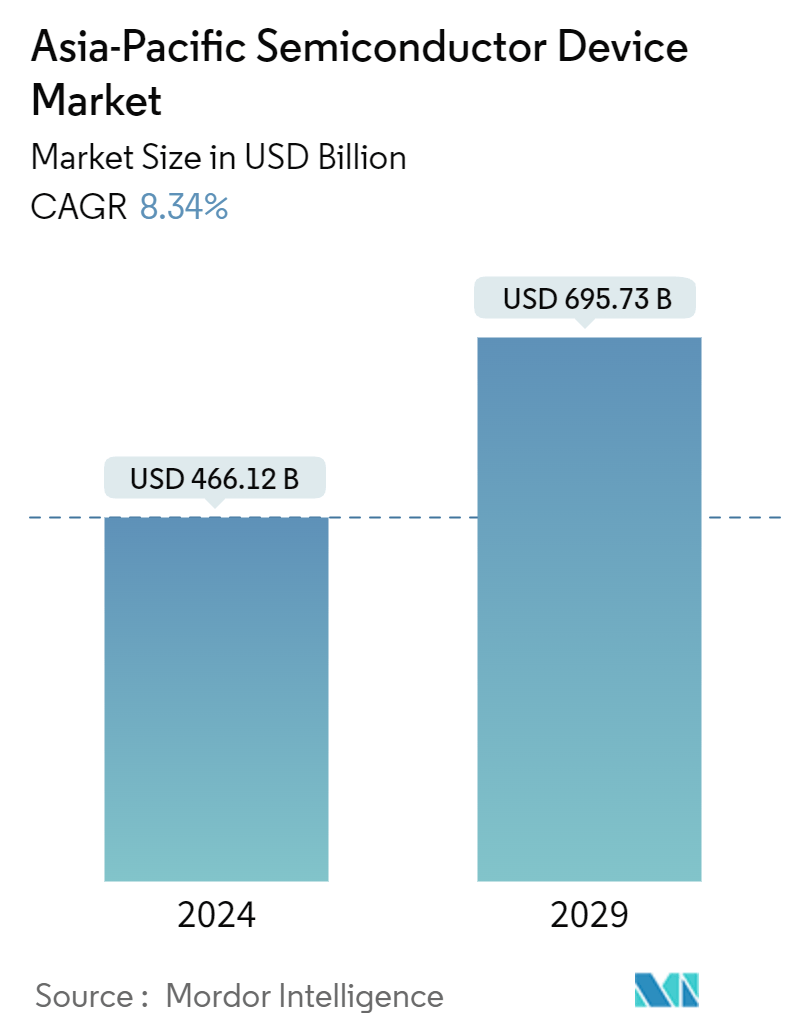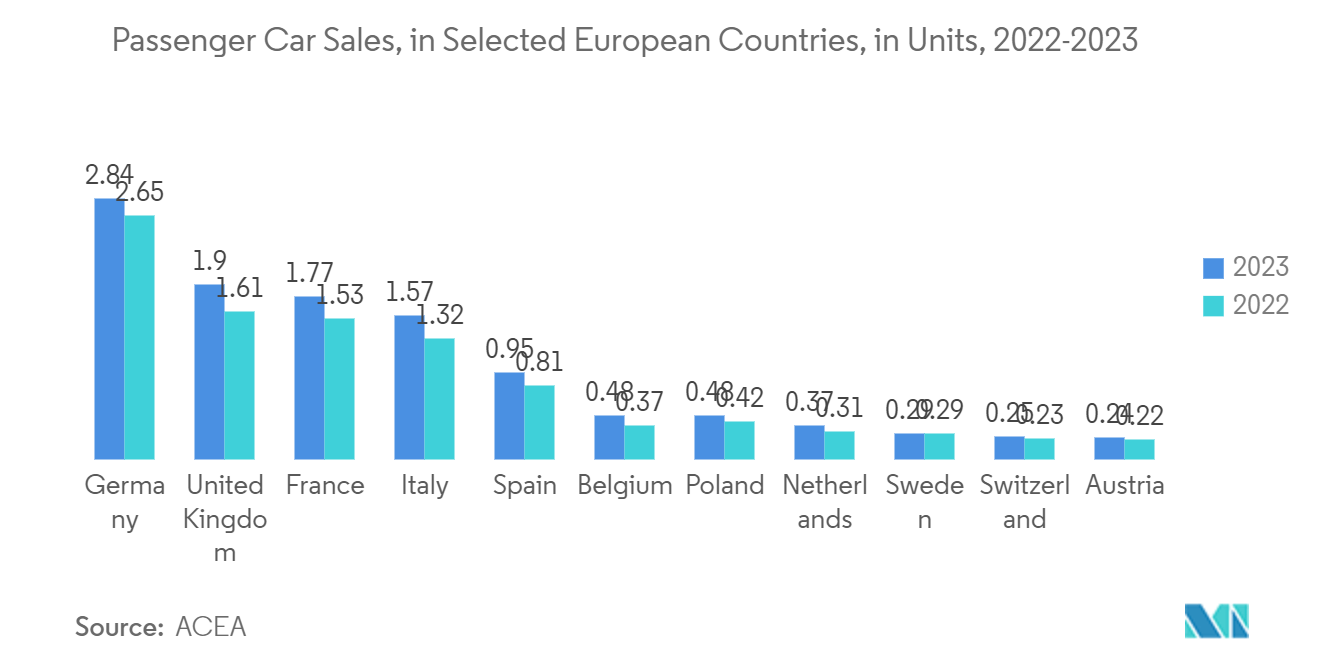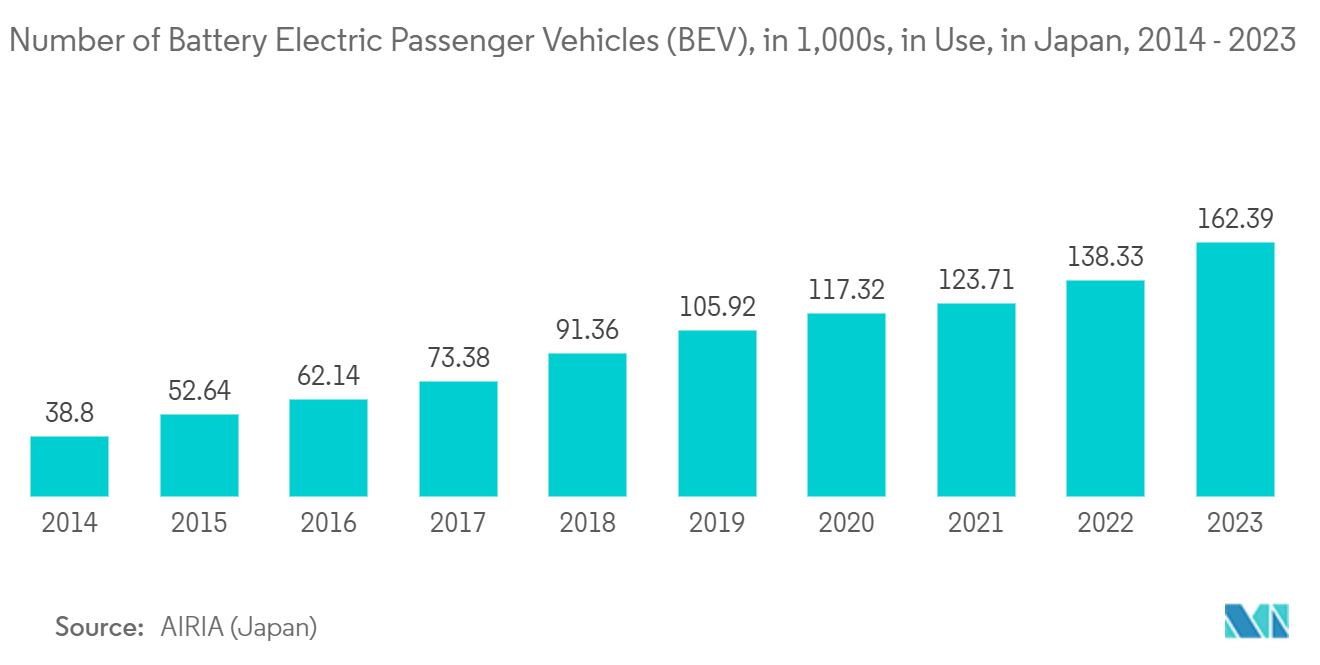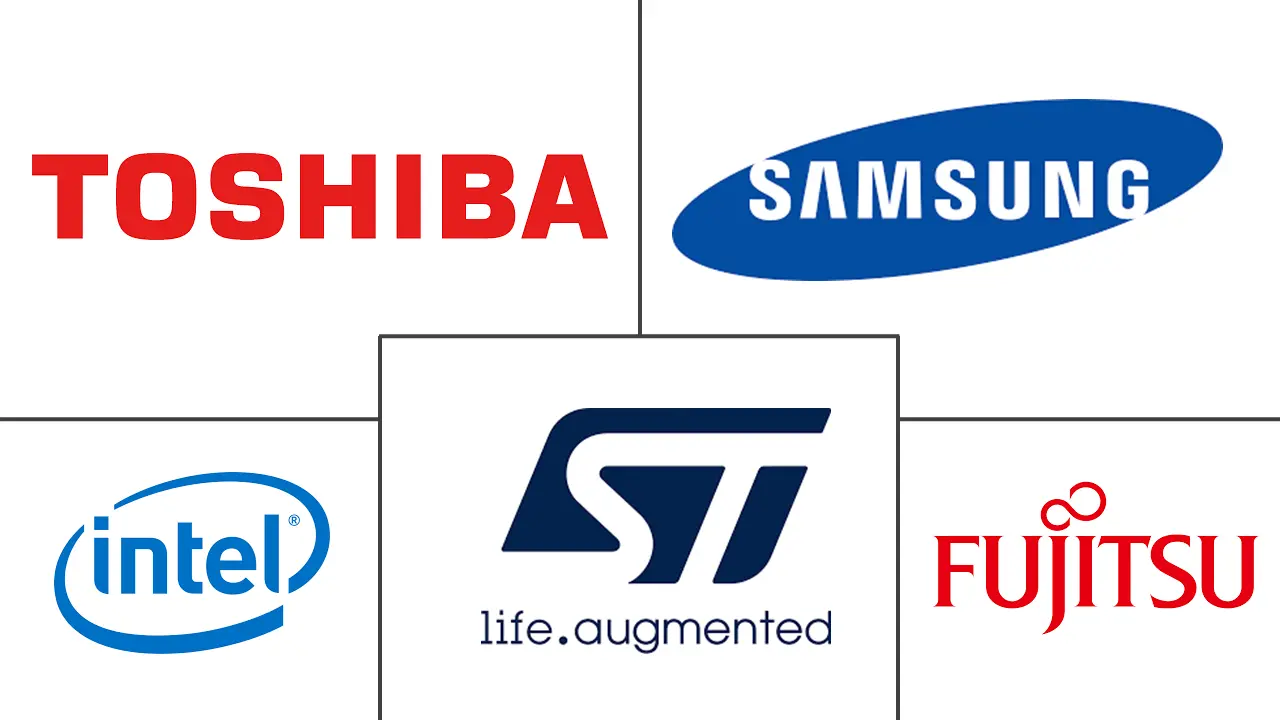Asia-Pacific Semiconductor Device Market Size

| Study Period | 2019 - 2029 |
| Base Year For Estimation | 2023 |
| Market Size (2024) | USD 466.12 Billion |
| Market Size (2029) | USD 695.73 Billion |
| CAGR (2024 - 2029) | 8.34 % |
| Market Concentration | Low |
Major Players*Disclaimer: Major Players sorted in no particular order |
Asia-Pacific Semiconductor Device Market Analysis
The Asia-Pacific Semiconductor Device Market size is estimated at USD 466.12 billion in 2024, and is expected to reach USD 695.73 billion by 2029, growing at a CAGR of 8.34% during the forecast period (2024-2029).
The increasing demand for semiconductor devices from the electronics and automotive industries is expected to contribute significantly to revenue generation in the coming years; however, a shortage of skilled labor-intensive tasks may impede industry expansion in the coming years.
- In recent years, India has witnessed a significant surge in the usage of connected devices, including smart home devices and wearables. According to Cisco, India will have around 2.1 billion Internet-connected devices by 2023. The country is also expected to cross the 900 million mark of Internet users, according to the recently published Cisco Annual Internet Report (2018-2023), owing to the increased penetration of affordable smartphones and cheaper Internet plans. Demand for connected devices will drive the market's growth during the forecast period.
- In April 2023, Japan's trade minister pledged the government will increase its financial support for chipmaker Rapidus as it works to develop advanced semiconductors, claiming domestic production of such components is crucial for the country to excel in artificial intelligence and autonomous driving. The project is noticed as a quasi-public sector effort, with Rapidus becoming a potential national champion as the country tries to develop a robust local chip sector. The government contributed USD 530 million in financial aid for its launch.
- Moreover, Taiwan Semiconductor Manufacturing Co. and Sony Corp., in November 2021, announced that they would establish a USD 7 billion chip facility in Japan by the end of 2024. As trade tensions between China and the United States threaten to disrupt supply chains and demand for essential components grow, Sony Corp. has announced a USD 500 million investment in factories to provide chips to Japan's electronic device makers and auto businesses. Such investments are likely to boost the growth of the studied market.
- Further, the growing reliance on digital connectivity across various end-user industries has led to a sharp rise in data usage worldwide. For instance, according to Nokia's annual Mobile Broadband Index (MBiT) report, the average data consumption per user in India reached 19.5GB per user a month in 2022, equivalent to 6,600 songs. Mobile data traffic in India jumped 3.2 times in the last five years, reaching over 14 exabytes per month towards the end of 2022. Increased online education, work-from-home model, and higher over-the-top (OTT) viewership increased data traffic. Such factors are aiding the growth of the market for data centers.
- Conversely, the semiconductor industry faces various challenges in developing and producing semiconductor devices. A major challenge is that as transistors continue to get smaller, maintaining the same performance and reliability becomes more challenging. Further, due to the high complexity of modern semiconductor devices, there is a need for efficient heat dissipation. Issues with thermal management can lead to reduced device lifetime and performance. However, variability among individual devices is prevalent in semiconductor manufacturing and can lead to problems with yield and reliability.
Asia-Pacific Semiconductor Device Market Trends
The Automotive Segment is Expected to Drive the Market's Growth
- Semiconductor devices can display several valuable properties. These include passing current easily in one direction rather than the other, sensitivity to light or heat, and displaying variable resistance. Devices made from semiconductors are used for amplification, switching, and energy conversion because of their ability to be modified through doping or by applying light or electrical fields.
- Automobiles are increasingly becoming computers on wheels. They now include heads-up displays, autonomous driving aids, sensors, cell phone and communication integration, and high-performance elements in their engines.
- Innovations in automotive connectivity, electrification, and autonomous driving are primarily achieved by integrating more electronics powered by a significant, growing silicon content. As vehicle production increases, the market growth for semiconductors in the automotive sector is expected to rise.
- Asia-Pacific is one of the most important markets for the automobile industry, owing to an increase in urban population and spending power. According to the China Association of Automobile Manufacturers (CAAM), approximately 965,000 passenger vehicles and 216,000 commercial automobiles were sold in China in April 2022. Such massive vehicle sales will allow the studied market to grow.
- Further, the NITI Aayog and Rocky Mountain Institute (RMI) predict that India's electric vehicle (EV) finance sector will reach INR 3.7 lakh crore (USD 50 billion) by 2030. Major automakers have begun investing extensively in various parts of the industry to meet rising demand in recent months. For instance, in March 2023, Taiwan-based tech company Foxconn announced that it is looking to invest in developing semiconductors and EVs in India.
- Additionally, the country is witnessing various partnerships by major vendors to boost the supply chain. In June 2022, Renesas Electronics Corporation announced a strategic partnership with Tata Motors Ltd. and Tejas Networks Ltd. to focus on developing semiconductor solutions for technologies across automotive, Internet of Things (IoT), and 5G Systems. Such developments would boost the penetration of semiconductor devices in the region's automotive sector.
- Further, the growth trajectory of fully-autonomous automobiles is expected to be heavily influenced by several factors, including technology advancements, consumer willingness to accept fully-automated vehicles, pricing, and suppliers and original equipment manufacturers' (OEMs) capacity to address significant concerns about vehicle safety. The growing demand for EVs in the Asia-Pacific region would cause an upsurge in demand for semiconductor devices.
- For instance, according to AIRIA (Japan), as of March 31, 2022, the number of battery electric passenger cars reached over 138.33 thousand, increasing from around 125.86 thousand in the previous year in Japan.

China is Expected to Witness a High Market Growth Rate
- In China, advancing technologies has contributed to the advancement of various consumer electronics, medical devices, telecom and communication devices, and automobiles, among others. With the launch of 5G services in the country, the necessity for the smartphone, among other things, has been increasing.
- According to the Ministry of Industry and Information Technology (MIIT), China aimed to have 2 million installed 5G base stations in 2022 to expand the country's next-generation mobile network. The Chinese mainland currently has approximately 1.425 million installed 5G base stations that support over 500 million 5G users nationwide, making it the biggest network in the world, as per MIIT. The increase in the implementation of 5G in the region is also anticipated to promote the demand for 5 G-enabled devices, thereby increasing the need for semiconductor devices in China.
- Further, according to China's State Council's "2014 National Integrated Circuit Industry Development Guidelines,' it aims to become a global leader in all semiconductor industry segments by 2030. Additionally, the "Made in China 2025" initiative maintains achieving knowledge with regard to advanced semiconductor manufacturing as a crucial component of China's future economy and society. It is highly focused on the strategy to build a strong manufacturing nation worldwide.
- The initiative is expected to encourage local and foreign companies to invest in the Chinese market across various segments, including integrated circuits. The initiative also prompts the government bodies to boost research and development activities so that China can rely on its own companies for core technologies rather than overseas ones. This is set to propel innovation in the semiconductor manufacturing industry, thereby boosting the growth of the semiconductor devices market.
- Moreover, as per the International Trade Administration (ITA), China continues to be the world's largest vehicle market in terms of manufacturing output and annual sales, with domestic production expected to reach approximately 35 million vehicles by 2025. Such an increase in the demand for automobiles in the region is also likely to push the need for the studied market further.
- China is one of the largest manufacturing giants in the number of manufacturing units operational for many industries in the Asia Pacific region. With the US-China Trade war, China has been focusing on motivating microcontrollers' domestic manufacturing. Hence, local manufacturers are following large-scale policies of vehicle electrification and others, creating high demands for microcontroller units (MCUs) and boosting domestic MCU manufacturing.
- For instance, in April 2022, Nanjing SemiDrive Technology Ltd. introduced the E3 series of advanced reduced instruction set computer (RISC) machine, advanced RISC machine (ARM)-based automotive microcontrollers. These are aimed at drive-by-wire chassis, battery management system (BMS), brake control, advanced driver-assistance systems (ADAS)/autonomous driving motion control, head-up (HUD), liquid-crystal display (LCD) instrumentation, and streaming media vision systems.
- Similarly, in April 2022, BYD, another semiconductor manufacturer from China, launched its new BS9000AMXX series of 8-bit MCU chips for vehicles. According to the company, the BS9000AMXX series is an 8-bit general-purpose MCU, and the chip uses an S8051 core with a central frequency of up to 24MHZ. Such developments are anticipated to offer lucrative opportunities for the region's studied market growth.a

Asia-Pacific Semiconductor Device Industry Overview
The Asia-Pacific semiconductor devices market is fragmented with the presence of several players like Intel Corporation, Kyocera Corporation, Toshiba Corporation, etc. The companies aim to continuously invest in strategic partnerships and product developments to gain substantial market share. Some of the recent developments in the market are:
In November 2022, the US electric vehicle giant Tesla joined a semiconductor joint venture in China, ramping up its activity in the automotive semiconductor sector as demand for new-energy vehicles soars in the auto market. With registered capital of USD 150 million, the venture would supply automotive chip and electronics solutions.
In October 2022, Aixtron Se, a prominent provider of deposition equipment to the semiconductor industry, received an order for an AIX 2800G4 MOCVD System from Furukawa Fitel Optical Device Co., Ltd., a Japan-based manufacturer of compound semiconductor devices. The equipment would be used to develop and produce optoelectronic devices based on Gallium Arsenide (GaAs) and Indium Phosphide (InP) materials.
Asia-Pacific Semiconductor Device Market Leaders
-
Intel Corporation
-
STMicroelectronics NV
-
Toshiba Corporation
-
Samsung Electronics Co. Ltd
-
Fujitsu Semiconductor Ltd
*Disclaimer: Major Players sorted in no particular order

Asia-Pacific Semiconductor Device Market News
- June 2024 - Vanguard International Semiconductor Corporation and NXP Semiconductors N.V. have unveiled their collaboration to establish VisionPower Semiconductor Manufacturing Company Pte Ltd ("VSMC"), a joint venture aimed at constructing a cutting-edge 300mm semiconductor wafer facility in Singapore. This new facility will specialize in producing 130nm to 40nm mixed-signal, power management, and analog products, with a strategic focus on automotive, industrial, consumer, and mobile applications. Notably, the joint venture plans to leverage process technologies licensed from TSMC.
- April 2024 - Infineon Technologies AG, a prominent power systems and IoT player, is bolstering its outsourced backend manufacturing presence in Europe. The company has unveiled a strategic, multi-year collaboration with Amkor Technology, Inc., a key player in semiconductor packaging and testing services. As part of this partnership, both entities will jointly run a specialized packaging and testing facility at Amkor's Porto manufacturing hub.
Asia-Pacific Semiconductor Device Market Report - Table of Contents
1. INTRODUCTION
- 1.1 Study Assumptions and Market Definition
- 1.2 Scope of the Study
2. RESEARCH METHODOLOGY
3. EXECUTIVE SUMMARY
4. MARKET INSIGHTS
- 4.1 Market Overview
-
4.2 Industry Attractiveness - Porter's Five Forces Analysis
- 4.2.1 Bargaining Power of Suppliers
- 4.2.2 Bargaining Power of Buyers
- 4.2.3 Threat of New Entrants
- 4.2.4 Intensity of Competitive Rivalry
- 4.2.5 Threat of Substitutes
- 4.3 Technological trends
- 4.4 Value Chain Analysis
- 4.5 Assessment of Impact of COVID-19 on the Market
5. MARKET DYNAMICS
-
5.1 Market Drivers
- 5.1.1 Emergence of new technologies like AI, and IoT
- 5.1.2 Increasing demand for Evs and ADAS
- 5.1.3 Increased Deployment of 5G and Rising Demand for 5G Smartphones
-
5.2 Market Restrains
- 5.2.1 High Raw Material and Fabrication Costs
-
5.3 Market Opportunities
- 5.3.1 Rising demand for data centers
6. MARKET SEGMENTATION
-
6.1 By Device Type
- 6.1.1 Discrete Semiconductors
- 6.1.2 Optoelectronics
- 6.1.3 Sensors
- 6.1.4 Integrated Circuits
- 6.1.4.1 Analog
- 6.1.4.2 Logic
- 6.1.4.3 Memory
- 6.1.4.4 Micro
- 6.1.4.4.1 Microprocessors (MPU)
- 6.1.4.4.2 Microcontrollers (MCU)
- 6.1.4.4.3 Digital Signal Processors
-
6.2 By End-User Vertical
- 6.2.1 Automotive
- 6.2.2 Communication (Wired and Wireless)
- 6.2.3 Consumer
- 6.2.4 Industrial
- 6.2.5 Computing/Data Storage
-
6.3 By Country
- 6.3.1 Japan
- 6.3.2 China
- 6.3.3 South Korea
- 6.3.4 Taiwan
7. SEMICONDUCTOR FOUNDRY LANDSCAPE
- 7.1 Foundry Business Revenue and Market Shares by Foundries
- 7.2 Semiconductor Sales - IDM vs Fabless
- 7.3 Wafer Capacity by end of December 2022 based on Fab Location
- 7.4 Wafer Capacity by the Top Five Semiconductor Companies and an Indication Of Wafer Capacity By Node Technology
8. COMPETITIVE LANDSCAPE
-
8.1 Company Profiles*
- 8.1.1 Intel Corporation
- 8.1.2 Kyocera Corporation
- 8.1.3 STMicroelectronics NV
- 8.1.4 NXP Semiconductors NV
- 8.1.5 Toshiba Corporation
- 8.1.6 Taiwan Semiconductor Manufacturing Company (TSMC) Limited
- 8.1.7 SK Hynix Inc.
- 8.1.8 Samsung Electronics Co. Ltd
- 8.1.9 Fujitsu Semiconductor Ltd
- 8.1.10 Infineon Technologies AG
- 8.1.11 Renesas Electronics Corporation
- 8.1.12 Broadcom Inc.
9. INVESTMENT ANALYSIS
10. FUTURE OF THE MARKET
** Subject To AvailablityAsia-Pacific Semiconductor Device Industry Segmentation
A semiconductor device is an electronic component that relies on the electronic properties of semiconductor material for its function.
The Asia-Pacific semiconductor device market is segmented by device type (discrete semiconductors, optoelectronics, sensors, integrated circuits [analog, logic, memory, micro [microprocessors, microcontrollers, and digital signal processors]]), by end-user vertical (automotive, communication [wired and wireless], consumer, industrial, and computing/data storage), and by country (Japan, China, Korea, Taiwan, and Rest of Asia-Pacific). The report offers market forecasts and size in value (USD) for all the above segments.
| By Device Type | Discrete Semiconductors | ||
| Optoelectronics | |||
| Sensors | |||
| Integrated Circuits | Analog | ||
| Logic | |||
| Memory | |||
| Micro | Microprocessors (MPU) | ||
| Microcontrollers (MCU) | |||
| Digital Signal Processors | |||
| By End-User Vertical | Automotive | ||
| Communication (Wired and Wireless) | |||
| Consumer | |||
| Industrial | |||
| Computing/Data Storage | |||
| By Country | Japan | ||
| China | |||
| South Korea | |||
| Taiwan |
Asia-Pacific Semiconductor Device Market Research Faqs
How big is the Asia-Pacific Semiconductor Device Market?
The Asia-Pacific Semiconductor Device Market size is expected to reach USD 466.12 billion in 2024 and grow at a CAGR of 8.34% to reach USD 695.73 billion by 2029.
What is the current Asia-Pacific Semiconductor Device Market size?
In 2024, the Asia-Pacific Semiconductor Device Market size is expected to reach USD 466.12 billion.
Who are the key players in Asia-Pacific Semiconductor Device Market?
Intel Corporation, STMicroelectronics NV, Toshiba Corporation, Samsung Electronics Co. Ltd and Fujitsu Semiconductor Ltd are the major companies operating in the Asia-Pacific Semiconductor Device Market.
What years does this Asia-Pacific Semiconductor Device Market cover, and what was the market size in 2023?
In 2023, the Asia-Pacific Semiconductor Device Market size was estimated at USD 427.25 billion. The report covers the Asia-Pacific Semiconductor Device Market historical market size for years: 2019, 2020, 2021, 2022 and 2023. The report also forecasts the Asia-Pacific Semiconductor Device Market size for years: 2024, 2025, 2026, 2027, 2028 and 2029.
Asia-Pacific Semiconductor Device Industry Report
Statistics for the 2024 Asia-Pacific Semiconductor Device market share, size and revenue growth rate, created by Mordor Intelligence™ Industry Reports. Asia-Pacific Semiconductor Device analysis includes a market forecast outlook to for 2024 to 2029) and historical overview. Get a sample of this industry analysis as a free report PDF download.




